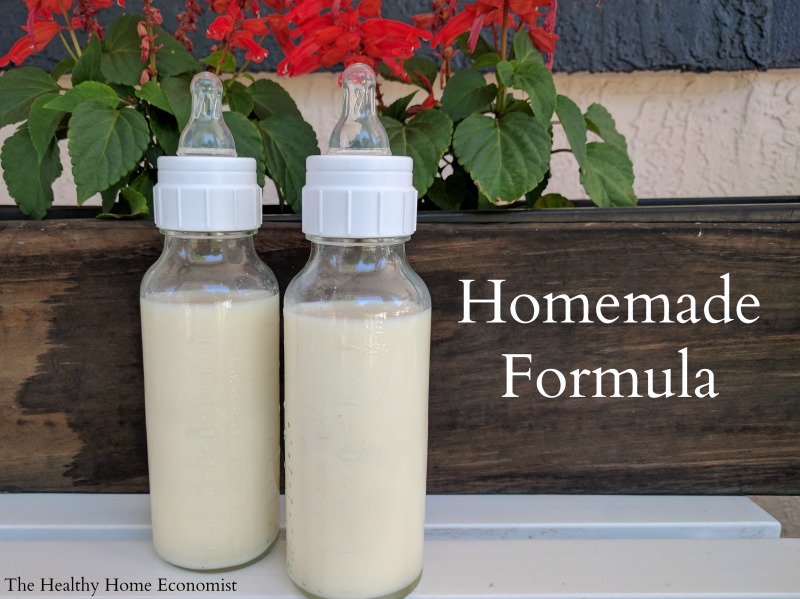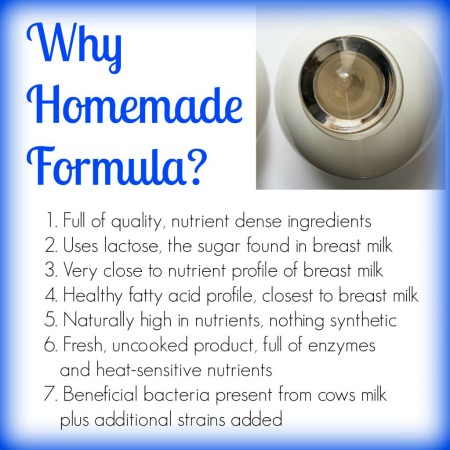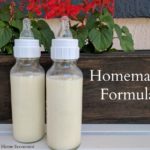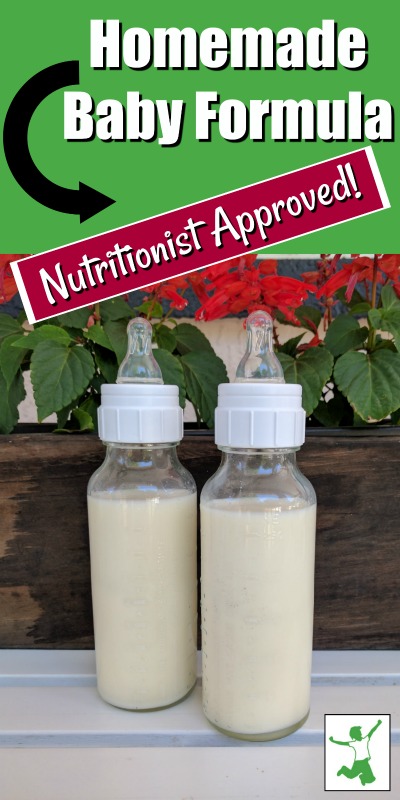Table of Contents[Hide][Show]
A nourishing homemade baby formula using safe, whole ingredients. This recipe was developed and tested by Dr. Mary Enig, a PhD Nutritionist and originally published in Nourishing Traditions cookbook in 1996. It was formulated to match breastmilk as closely as possible and is also suitable for infants. Source: Weston A. Price Foundation

There is no doubt that breastfeeding your baby is the best option for the child’s long-term health and development. Human breastmilk from a well-nourished mother is the perfect food for baby. However, in circumstances where the child is adopted or the Mother finds herself unable to breastfeed, formula feeding becomes necessary. In those cases, homemade baby formula is best.
Using a baby formula recipe that closely matches the nutritional profile of breastmilk is a far better choice than even organic baby formula from the health food store. More on this below.
Note: Donor programs are widely available for human breastmilk. But, the diets of the donor mothers are unknown and most likely nutritionally insufficient. In addition, breastmilk banks pasteurize the donated breastmilk which destroys much of the nutritional benefit. Unless you are fortunate to have a trusted and direct donor milk source in your community, avoid this option!
Dangers of Commercial Formula
Commercial formulas are always a poor choice for a number of reasons. First of all, formula manufacturers line the cans with the chemical BPA. This substance disrupts hormone development and is a probable contributor to early puberty in girls, and ADHD, urogenital abnormalities, and other ills in boys.
The European Food Safety Authority found that canned commercial formula is a significant source of BPA for infants, exposing the child to 13mcg of BPA per kg of body weight per day! BPA-free formula cans are no better. The chemical BPS is typically used instead which is just as dangerous.
Beware that manufacturers pack even organic commercial formula like Earth’s Best in BPA cans. Worse, they use organic brown rice syrup as the primary sweetener which is known to be frequently contaminated with arsenic.
In addition, all commercial milk formulas are processed at extremely high temperatures which violently denature the fragile milk proteins, render them allergenic, and add carcinogens to the final product. Soy infant formula is the worst. Obscenely high processing temperatures not only denature the proteins but large levels of phytic acid in soy block mineral absorption by the infant. Moreover, soy-based plant estrogens disrupt the hormonal development of the baby!
It seems that for the concerned Mother who is unable to breastfeed, learning how to make baby formula at home with safe, pure ingredients is the most prudent way to go!
Why Make Homemade Formula Even if You Are Breastfeeding
In the video below, I show you how to make your own safe, healthy raw milk homemade formula for your baby.
The recipe I follow was originally published in the cookbook Nourishing Traditions in 1996 and developed by Dr. Mary Enig.
Even though I breastfed each of my children for at least 2 years, I made this exact formula for my own children when I was away for the day or the evening as pumping was not an option that worked well for me.
I even used this homemade formula for an entire day once when I had some dental work done and was advised to pump and discard for 24 hours.
As a result, even successfully breastfeeding Moms can use this wonderful homemade formula as a supplement when necessary to their own nutrient-dense breastmilk!
It is advised that even breastfeeding Mothers have the ingredients for this formula on hand for an emergency. If Mom is sick or otherwise unable to nurse, Dad can step in and make this safe alternative until Mom is back on her feet. It takes a few days to a week to gather all the ingredients together to make this formula, which is why I advise having them on hand at all times.
Homemade Most Nutritious
The image below lists the reasons why it is worth it nutritionally to make formula yourself for your precious baby!
You can order all of the required ingredients for the homemade baby formula in one package from this reputable, vetted source.
Moms who have successfully used this formula feeding your children, please post about your experience in the comments section to encourage those who are considering it and need some Mom to Mom encouragement!

Where to Source Quality Milk
The most widely available grass-fed milk around the world is from cows. This is usually the most budget-friendly and easily sourced milk for this recipe for homemade formula.
If only goat milk is available in your area, this recipe for goat milk baby formula can be used instead. When using milk from ewes, please refer to the linked article for an adjusted recipe; one of the benefits of sheep milk is that it is higher in healthy fats than either goat or cow milk.
Camel milk formula is another option that is a particularly digestible form of dairy and growing in popularity around the world.
Alternatively, you can use low temp (vat) pasteurized, non-homogenized whole milk cultured with a piima or kefir starter. Then substitute the piima milk or kefir for the raw milk portion of the formula recipe. Cold-pressed raw milk also must be cultured before using it as it contains no probiotics.
Do NOT use ultrapasteurized (UHT) milk even if organic as it is too highly processed and extremely allergenic!
It is also best to avoid all types of powdered milk for this recipe. The factory process of making milk powder reduces nutrition considerably and denatures it, which makes it more likely baby will have an allergic reaction.
Dairy Allergy Option
If all types of dairy prove unsuitable for your baby, make this nondairy baby formula recipe instead. It uses a base of homemade bone broth as a substitute for milk. It is important not to utilize a plant-based or otherwise vegan baby formula recipe.
Avoid buying bone broth to make the dairy-free formula. Make it yourself! Manufacturers of commercial bone broth, even if authentic, may water down the end product. This is apparent if it does not gel when chilled in the refrigerator.
Many brands have toxic packaging issues as well. If you must buy it in a pinch, see my shopping guide page for vetted brands that are safe.

Homemade Baby Formula Recipe (for infants too)
A nourishing baby formula recipe you can make at home with safe, whole ingredients developed and tested by a PhD nutritionist to match breastmilk as closely as possible. Also suitable for infants.
Ingredients
- 2 cups raw cow milk OR organic whole milk yogurt
- 1 7/8 cups filtered water
- 1/4 cup liquid whey
- 4 Tbl lactose
- 1/4 tsp Bifidobacterium infantis powder
- 2-4 Tbl raw or pasteurized cream
- 1/2 tsp cod liver oil unflavored
- 1/4 tsp butter oil unflavored
- 1 tsp sunflower oil preferably organic
- 1 tsp extra virgin olive oil preferably organic
- 2 tsp virgin coconut oil preferably organic
- 2 tsp nutritional yeast
- 2 tsp gelatin
- 1/4 tsp acerola powder
Instructions
-
Fill a 2 cup Pyrex measuring cup with filtered water and remove 2 TBL (this will give you 1 7/8 cup water).
-
Pour about half the water into a pan and turn burner on medium.
-
Add the gelatin and lactose and let dissolve, stirring occasionally.
-
When gelatin and lactose are dissolved, remove pan from heat and add the rest of the water to cool.
-
Stir in the coconut oil and butter oil until melted.
-
Put remaining ingredients in a glass blender.
-
Add the water mixture and blend for about 3 seconds.
-
Place formula in glass baby bottles or a glass jar and refrigerate.
-
Before giving to baby, warm glass bottle in a pan of hot water or a bottle warmer. NEVER microwave baby bottles!
Recipe Video
Recipe Notes
If using raw cow milk from holstein cows, use 4 Tbl of extra cream (otherwise use 2 Tbl extra cream).
If choosing to make this homemade formula with camel milk, be sure to include 4 Tbl extra cream as camel milk is lower in cream than cow milk.
Do not use high oleic sunflower oil. Use only the brand recommended in the ingredients list which is cold pressed, organic, unrefined, and low oleic.
*Do NOT use powdered whey from the store as it is denatured. Avoid whey from making cheese as it will curdle the formula.
*Do not substitute pasteurized or powdered milk as these are heavily processed, denatured and allergenic foods.
*Do NOT use ultrapasteurized (UHT) cream. It is highly allergenic. Raw or pasteurized cream is acceptable.
*Do NOT use fish oil or krill oil instead of high vitamin cod liver oil as they do not contain any Vitamin D and very little to no Vitamin A.
Collagen powder may be substituted for the gelatin in a pinch (more on peptides in baby formula in this article).
If you are wondering where is the iron in homemade baby formula, this article provides an explanation.
If baby experiences constipation using this formula, try adding 1 tsp of molasses to each batch. This should help move things along.
How to Transition to DIY Formula
Once you’ve viewed the video, gathered the ingredients, and made your first batch, how do you feed it to your baby for the first time?
It is important not to switch all at once as this can cause gas, excessive spit-up, or an uncomfortable change in diaper habits such as constipation or overly loose stools.
Start by giving your baby three-quarters of the old formula blended with one-quarter of the homemade. Try this ratio for a day or two and see how your infant responds.
If no digestive upset or major change in diaper habits occurs, increase the amount to a 50-50 blend of old formula to homemade. Observe for another day or two as before.
If no major issues, increase once again to three-quarters homemade formula to one-quarter old formula. If baby does well on this blend for a third time, you are ready to fully transition to the homemade formula.
At any time during the transition, symptoms of intolerance emerge, back up to the previous successful blend ratio and stay there for a day or two before attempting to increase once again.
Homemade Formula FAQ
Weston Price Foundation
Feeding an Adopted Baby
Traveling Tips with Baby Formula Made at Home
Iron in Baby Formula
Collagen Peptides instead of Gelatin for Homemade Formula?










I love this formula and it is really not as hard as you think once you get into the routine. I use the goat milk formula and noticed right away my baby became constipated. I switched to a goat milk derived lactose from Mt Capra and this resolved the issues. Great alternative for moms concerned about cows milk derivatives. I spoke with the people at Radiant Life and they said they would look into carrying this.
Thanks for the tip!
Thank you so much for this information! I was able to find a local co-op that sells raw milk, however, the cows are fed corn regularly in addition to being grass fed.
From the farm:
“The cows are grazed anon chemically treated organic pasture and supplemented with organic non-GMO corn and baleage.”
Would you recommend still using milk, whey, and cream from these cows?
Thank you!
Hello! I’m seriously considering switching from commercial formula to this homemade recipe but I have a couple of questions.
In light of recent concerns over the quality of fermented cod liver oil is it ok to substitute with regular CLO?
Also, do you have the nutritional facts for this recipe? I’m particularly intrested to know about the minerals that are included in this recipe. Thank you for your consideration!
Yes, of course you can substitute regular nonfermented cod liver oil. Please see the WAPF approved brands here: http://www.westonaprice.org/health-topics/cod-liver-oil-basics-and-recommendations/
Thank you so much for this information! I was able to find a local co-op that sells raw milk, however, the cows are fed corn regularly in addition to being grass fed.
From the farm:
“The cows are grazed anon chemically treated organic pasture and supplemented with organic non-GMO corn and baleage.”
Would you recommend still using milk, whey, and cream from these cows?
Thank you!
My 17 mo old has been on this formula since she was 5 mos old and has done great on it! We moved about 6 months ago and had to find a new milk share. Everything had been going fine until a week ago when my daughter started having very loose stools. I’ve eliminated any solid foods that might be the culprit and the loose stools/diarrhea still continues. Our farmer told us that the cows have recently switched from eating hay to grazing on grass again for the season. Any chance the change in the cows’ diets is what is causing the loose stools?
Just wondering why a 17 month old toddler is still on the homemade formula? Switching to plain raw cow or goat milk is suggested after the child turns a year old.
In answer to your question, I don’t think the cow’s dietary switch would impact anything. Perhaps the child has a gastrointestinal illness of some kind. Best to seek out a doctor’s advice.
Hello
my baby is 2 weeks, I modified the formula milk for best adaptation, she takes organic raw buffalo milk. I removed the yeast, cream and increased 50 ml of water and milk.
However in some feedings she throws up and takes a little milk. That’s really the adaptation?
Not sure where you got those adaptations? Substituting raw buffalo milk for the raw cow milk portion of the recipe 1:1 is fine. Only remove the yeast if she cannot tolerate it.
Thanks dear Sarah.
how much milk should I take per day? my baby hasn’t gained weight since birth, has 15 days left to live. the development is slower?
Please do consult with your practitioner about that question.
Dear Sarah:
First and foremost, WOW! I’m in awe of your blog, advice, and knowledge. I’m a first time mom, and I’ve found your information to be quite helpful. I was exclusively breastfeeding for the first four weeks of my baby’s life, however, she was losing weight and vomitting almost non stop. To my disappointment, the pediatrician said my only option was formula. At the time, I was so sleep deprived, worried, and hopeless, I listened without giving it a second thought. My baby gained 1 lb in five days and I was ecstatic…until I read the ingredients in the formula her doctor recommended. Oh my goodness. This stuff should be illegal!
Anyway, long story short. My milk dried up and I didn’t have a chance to even try supplementing because I put my faith in my pediatrician, not thinking to my gut. Now, I am in deep need of a healthy solution to keeping my daughter on the right dietary track. So, I am going to make your formula and I hope it works for her (I suspect she has a lactose intolerance, she is currently on a lactose free formula). And so I have just a few questions I am hoping you can answer for me.
1. Can this homemade formula recipe be given to an 8 week old infant? Or is the whole raw milk to rich in fat?
2. Is there an ingredient that can stand in as a substitute to lactose?
3. What is your recommended fridge store time for this formula?
Ceasing breastfeeding was a traumatic experience for me, and I regret it very much. I felt like I failed my baby, and as though I broke our bond. However, I found your site and I am filled with new hope, even though I will never be able to get back those moments of breastfeeding.
Thank you in advance for any and all information you’re able to provide.
Sincerely,
Tina
Hi Tina, yes, this formula is fine for an infant of 8 weeks. There is no good substitute for the lactose … remember Mother’s milk is very rich in it! One to at most two days for this formula. It is ideally made everyday, but once you get the hang of it, it takes less than 10 minutes to make a batch.
Hi, Thank you for the video and information. I have been really looking into making this formula for my 9 month old as a supplement because I just don’t seem to be able to express enough for while i’m away from her, which is just 2 days a week, and probably just 2-3 bottles. Do you have an estimate of about how long these ingredients would last for making it for just a couple bottles a week? Thanks again.
You can reduce the recipe to make smaller amounts as needed. Once made, the formula really should be used within a day or two at most.
my baby is supplemented 95% on the cows formula as I can’t produce much milk. I think he is allergic to the whey and yeast. Is this formula still good with both of those foods taken out and is there something I can replace them with? If I have to use the liver recipe for my 7 week old which bone broth recipe do I use. I have the nourishing traditions book do i use the recipe in the book,does it have to be exact do I need to use the peppercorn and how long do I simmer the broth for does it matter if it’s under 72 hours?. Does it have to be an exact 4 lb of bones? Please help
Sarah, I had been making homemade formula for my foster baby for two weeks and he did great then had intestinal distress. Weston Price recommended leaving out nutritional yeast and gelatin which I did and he has been betters or over a week. Should I try reintroducing these, maybe one at a time? And if so which one first? Thanks, Jane
Try the gelatin first and use less than the recipe calls for and work your way up.
I was just wondering if this can be frozen for any amount of time? I’m just wondering for the time right after the baby is born and it’s more difficult to make the formula. Would it be ok to make up a week or two’s worth all at once and pull a batch out everyday?
Yes, you can keep some frozen for an emergency, but it is best to make it fresh for baby every day or every other day.